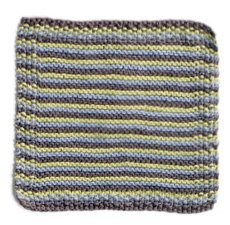This column by Barbara Breiter, author of The Complete Idiot’s Guide to Knitting & Crocheting, originally appeared in The Weekly Stitch newsletter.

When working a pattern in stripes, sometimes you’ll see an instruction “Carry the yarn not in use along the side” (as with the Knit Shell Beach Washcloth shown at right); other times you won’t see an instruction at all.
What should you do then? “Carry the yarn along the side” means nothing more than leave the color you are currently not using at the side of your work without cutting it. You’ll pick it up again later when you are to use that color again. If you are not going to use the color for 4 more rows, the next time you are at the edge where the unused yarn is, you will need to twist it with the color you are using. This will keep a loose loop from forming (the loose loop might get snagged or look unattractive if it isn’t twisted into the other yarn).
If you’re working 2 rows of one color followed by 2 rows of a second color, carrying the unused yarn makes sense, because all the color changes are on one edge of the piece, meaning that you can simply pick up the next color at the side and proceed.
If you’re alternating three colors, working 2 rows each, you will need to twist both colors not in use. Drop the color you just finished behind the other two, twist the other two, pick up the next color you need and continue.
If the pattern is anything other than 2 rows of color A followed by 2 rows of color B, even though you’ve been told to carry it, you still have a personal choice to make and should consider several factors that may lead you to cutting it every time instead. The down-side to cutting the yarn is that you will have many more ends to weave in (but if you weave in as you go, this task will not be as daunting). The upside? The row edges will be much neater. This should be especially considered when you are making a scarf or a throw where the edges will be seen (as with the Quintessential Country Afghan, shown left). In a sweater, the edges will be hidden in a seam; however, the seams will be bulkier because you’ve carried the yarn so that’s a negative factor to consider.
There is no hard and fast rule but generally if you are going to be working more than 4 rows before needing the color again, strongly consider cutting it. Some people will stretch this to 6 rows. Every time you twist the yarns, you are adding more bulk to the edge.
And you can always weave in those ends while watching TV.
–-
Get a FREE weekly email featuring patterns, articles and special offers. As a bonus for subscribing, we’d like to offer you 15% off your first order! *
:: Sign up now ::
* offer valid only for first-time email subscribers, one coupon per person.
Should You Carry the Yarn Along the Side or Cut It? | Yarn Buyer
[…] http://blog.lionbrand.com/2014/08/11/should-you-carry-the-yarn-along-the-side-or-cut-it/ […]
Should You Carry the Yarn Along the Side or Cut It? | Lion Brand Notebook | G-Ma Ellen's Hands – Adventures in Crochet and Knit
[…] Should You Carry the Yarn Along the Side or Cut It? | Lion Brand Notebook. […]
Should You Carry the Yarn Along the Side or Cut It? | Crochet Wisdom
[…] Source: blog.lionbrand.com […]
Further Reading 8/22/14 | Knit York City
[…] Lion Brand’s blog has some handy instructions on carrying vs. cutting yarn at the end of rows. I had a huge debate about this when I was working on the Hurrication […]
texascat
Just a hint from someone who has been knitting for 70 years, if you have cut the ends, and it is a thicker yarn, I split the strands and sew each strand into alternate rows. it gets rid of bulky seams
texascat
Just a hint from someone who has been knitting for 70 years, if you have cut the ends at the side of the knitting, and the yarn is heavier, I split the yarn into how ever many strands it has woven together and sew each one in on different rows. This really helps to not have bulky seams.
Deborah Hale
Or you could splice the yarn, also known as a Russian Join, if you don’t want to weave the ends in later. I have a few afghan patterns where I use this method. http://blog.lionbrand.com/2012/06/19/how-to-russian-join-yarn-in-7-easy-steps/